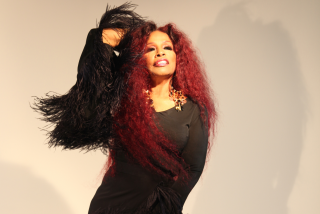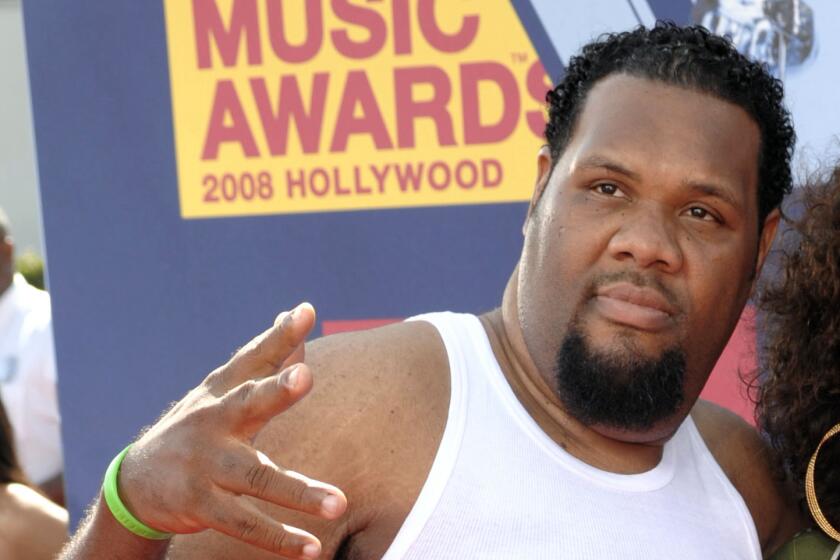POP MUSIC : At 17, the Girl Can’t Help It . . . She Likes the ‘60s
SAN DIEGO — She’s 17, blond, bubbly and cute--and very much your Ordinary High School Senior.
She hates homework and loves the beach. She dresses right, talks right and hangs with the right people at La Jolla Country Day School to ensure her good standing with the exclusive private academy’s very cool, very hip in-crowd.
But when it comes to music, Holly Denton is anything but ordinary. She doesn’t idolize the same pop heroes most of her friends do, faddish Top 40 faves like Prince, Tiffany, and Terence Trent D’Whatever.
Holly’s devotion lies with such early 1960s girl groups as the Chiffons, the Marvelettes, and the Shirelles, whose effusive, harmonic vocal hits reflected teen passions, and captured teen hearts, years before--practically a whole decade before--she was even born.
“When I was about 10, I started listening to my parents’ records, and most of the stuff they had was from the 1960s,” Holly said. “Right away, I was hooked--especially to all those great songs by the girl groups.
“I love the three-part harmonies, the background sha-la-las and shooby-doo-wahs, and the innocence of the lyrics and the titles: ‘My Boyfriend’s Back,’ ‘He’s So Fine,’ ‘He’s a Rebel.’ Everything is just so much better than the music that’s coming out today. It makes people think back to when they were young, when life was simple and fun.”
Tonight, Holly’s talk will turn into action when the Ravells make their public debut at the Palisade Theater in North Park.
Along with fellow singer Donna Taylor, Holly will belt out “One Fine Day” by the Chiffons, “Please Mr. Postman” by the Marvelettes, “Will You Still Love Me Tomorrow?” by the Shirelles, and maybe a dozen more of the 60-plus vintage girl-group classics the nine-member San Diego group has mastered over several months of almost daily rehearsals.
After that, the Ravells expect to find steady work at local conventions, private parties, and charity functions thanks to the Ravel Talent Agency of Pacific Beach, which assembled the band as a way of latching onto the big 1960s nostalgia craze currently sweeping the nation.
Besides Holly Denton and Donna Taylor, the Ravells’ band members include keyboardist Julius (Jewels) Petty, drummer Seymour Koblin, guitarist Steve Guerrero, and bassist Mark Langford. Rounding out the group’s line-up is a three-piece horn section consisting of Dean Ratzman, Steve Dillard, and Chris Klich.
Their average age? Let’s just say it is roughly twice Holly’s.
“I’m constantly telling everyone I was born too late,” Holly said wistfully. “I wish I could have been around when kids my age were dancing the watusi, the twist, the mashed potato, and the pony. Still, age really doesn’t mean a thing. The other guys in the band are always laughing because I know so much more about girl groups than they do.
“Whenever they have a question about who sang what, they ask me.”
At the start of this decade, San Diego jazz musician Mitch Manker, who plays trumpet and some high-tech gadget called the electronic valve instrument, stood with one foot in heaven and the other in hell.
In 1980, Manker said, he fulfilled his life’s ambition “of going on the road with a Big Band” when he beat out more than 200 other trumpet players for a seat in the touring Ray Charles Orchestra. That year and the next, Manker accompanied the legendary rhythm-and-blues singer on two nine-month world tours, with concert dates throughout Europe, North America, and even South Africa and several countries behind the Iron Curtain.
But the pressures of non-stop touring, Manker said, eventually turned him into a serious substance abuser. You name it, he would drink it, swallow it, snort it or shoot it.
“It got to the point where I was constantly strung out on booze, Valium, cocaine and heroin,” he said. “In 1981, I had three overdoses, and when the tour was over, I decided I needed to get off the road, get out of this hell, and get some help, quick.”
Manker promptly joined a San Diego chemical dependency recovery program. It took him nearly two years to kick his various habits and “go clean,” he said--two years of nightly rap sessions with other recovering addicts, two years of professional counseling, two years of forcing himself to admit his dependencies and two years of trying hard to overcome them.
Upon his release from the program in August, 1983, Manker returned to the local nightclub circuit and began rebuilding his career--and his life.
Until last January, he backed pop-jazz singer Ellaruth Piggee. Since then, he has divided his time between gigs with Dr. Chico’s Island Sounds, a calypso-reggae group, and his own jazz quartet, which performs each Wednesday night at Croce’s downtown.
But Manker, 32, isn’t one to forget past kindnesses. So Sunday morning, he and another one-time drug-using musician, synthesist George Emerson, will team up for a benefit concert, aboard the Bahia Belle, for the Vista Hill Foundation’s chemical dependency recovery program--the same type of program that Manker and Emerson credit with saving their lives.
“George and I are doing this concert to celebrate our sobriety and to show people that it’s possible to have fun without booze or drugs,” Manker said.
Tickets for the “No Booze Cruise,” which departs from the Bahia Resort Hotel on Mission Bay at 9:45 a.m. and returns at 1 p.m., are $15.
More to Read
The biggest entertainment stories
Get our big stories about Hollywood, film, television, music, arts, culture and more right in your inbox as soon as they publish.
You may occasionally receive promotional content from the Los Angeles Times.










